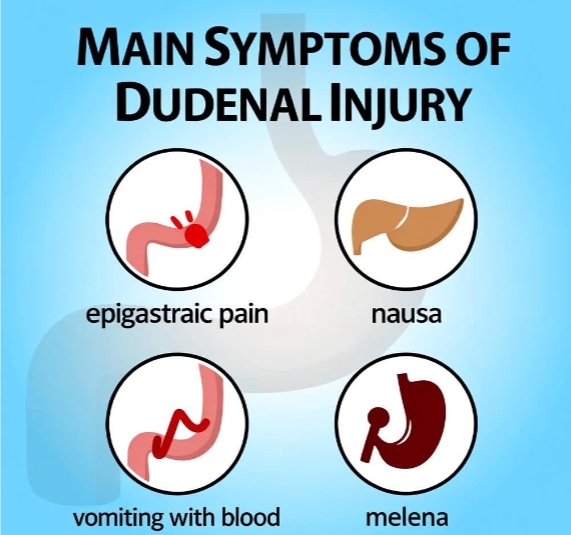Duodenal injury is partial or full-thickness damage to the first through fourth portions of the duodenum, most often caused by blunt abdominal trauma, penetrating wounds, or iatrogenic events during surgery. Because the duodenum is retroperitoneal and closely related to the pancreas, bile duct, and major vessels, early symptoms may be subtle and delayed, but rapid progression to peritonitis or septic shock is possible. Recognising the characteristic pattern permits timely imaging and operative repair.
- Early post-injury signals
Epigastric pain: deep, boring, and radiating to the back because of retroperitoneal irritation; not relieved by simple analgesics.
Nausea and bilious vomiting: gastric outlet obstruction or duodenal wall edema leads to persistent vomiting of clear yellow bile.
Abdominal wall bruising: seat-belt sign or localized ecchymosis across the upper abdomen suggests high-impact compression.
Transient hypotension and tachycardia: may be the only clue in an awake patient before overt peritonitis develops. - Evolving peritoneal signs
Rigid abdomen and guarding: retroperitoneal contents leak into the lesser sac and then the peritoneal cavity, producing board-like rigidity.
Absent bowel sounds: paralytic ileus follows chemical irritation from bile and pancreatic enzymes.
Shoulder-tip pain: diaphragmatic irritation from retroperitoneal air or fluid.
Fever >38 °C and rising white cell count: indicate bacterial contamination or associated pancreatic injury. - Occult or atypical presentations
Delayed pain 12–48 h after trauma: small wall hematoma may initially seal, then rupture.
Bilious drainage from a surgical drain or wound: iatrogenic injury recognized post-operatively.
Children with handlebar blow: vague pain and vomiting can masquerade as gastroenteritis until bilious output persists. - Complication markers
Continuous bleeding with hematemesis or melena: associated duodenal vessel injury.
Rising serum amylase and lipase: concurrent pancreatic trauma.
Free intraperitoneal air on imaging: full-thickness perforation.
Unexplained tachypnea and oliguria: developing septic shock.
Summary table
| Symptom complex | Typical timing | Alarm significance |
|---|---|---|
| Epigastric back pain | Immediate | Deep, unrelenting → CT scan |
| Bilious vomiting | 1–6 h | Persistent → obstruction or leak |
| Board-like rigidity | 6–12 h | Peritonitis → theatre |
| Fever, rising WBC | 12–24 h | Sepsis → urgent repair |
| Shoulder-tip pain | Any time | Retroperitoneal air → laparoscopy |
